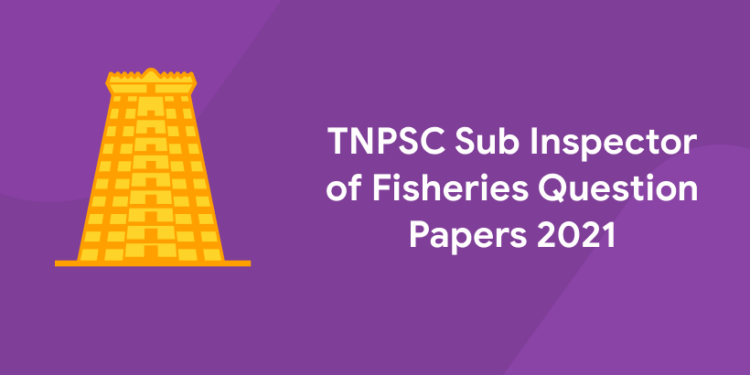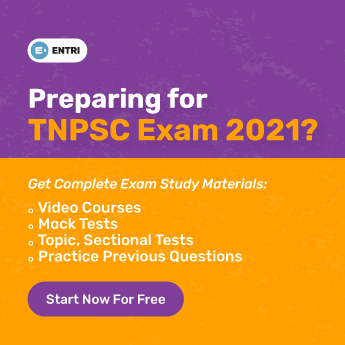Table of Contents
Aspirants preparing for the TNPSC Sub Inspector of Fisheries 2021, can download the old question papers. These previous papers of the Zoology, Fisheries Science, Fisheries Technology / Fisheries Science / Fisheries Technology and Navigation Engineering, and the General Studies will help candidates to prepare for the upcoming exams. Download the TNPSC Sub Inspector of Fisheries question papers PDF for all these subjects from the direct links provided below.
TNPSC Sub Inspector of Fisheries Question Papers PDF Download
As always it is very much evident that the practice of previous question papers for these subjects will give an idea of the examination. Tamil Nadu PSC Sub Inspector of Fisheries question papers will give a large number of questions, and the areas focused in that particular year. And, candidates can now concentrate on these areas. In this session, aspirants can download the free PDFs of the TNPSC Sub Inspector of Fisheries question papers, compiled for ease of practice. Make use of these question papers and practice more questions and ace your preparations for the TNPSC SI fisheries.
- Sub Inspector of Fisheries Previous Question Paper 1
- Zoology 2016
- Mechanical Engineering 2016
- Fisheries Science 2016
- Fisheries Technology Diploma 2016
- General Science 2016
- Zoology – Degree Std 2019 (Subject Code 270)
- Fisheries Science – Degree Std 2019 (Subject Code 328)
- Fisheries Science – Diploma Standard 2019 (Subject Code 327)
- General Studies 2019 (Subject Code 003)
Practice more previous question papers of various TNPSC Examinations
Exam Pattern and Syllabus for TNPSC Sub Inspector of Fisheries
Now, before attempting some previous questions from all the sessions/ subjects of the SI Fisheries, let us go through the examination pattern and the syllabus in brief. Candidates, check the answers, after attempting the previous questions, in the marking scheme of the examination.
Sub Inspector of Fisheries exam includes two papers viz., Subject Paper, Paper-I, and General Studies, Paper-II. The duration of the examination for Paper I will be 3 hours and that of Paper-II will be 2 hours.
Paper I include three papers, Degree Standard Zoology, Degree Standard Fisheries Science, and Diploma Standard Fisheries Science. And, this can be selected by the candidate according to the main subject of their graduation. There will be 200 questions in Paper I and the maximum marks awarded will be 300.
And, Paper-II, includes two subjects like Diploma Standard General Studies, and SSLC Standard Aptitude and Mental Ability. Paper-II includes 100 questions [General Studies – 75 Questions, Mental Ability – 25 Questions] for a total of 200 marks with a duration of 2 hours.
The second phase will be Interview and document verification. The candidates qualified for the written examination, will be shortlisted for the Interview and records, which consists of 70 marks. Altogether the selection procedure will be out of 570 marks.
Now, check the Tamil Nadu PSC Sub Inspector of Fisheries syllabus in brief.
Paper I Syllabus
| Zoology | Fisheries Science | Fisheries Technology / Fisheries Science / Fisheries Technology and Navigation Engineering |
| Cell and Molecular Biology, Genetics, Bio-informatics
Bio Chemistry, Development Biology, Environmental Biology Evolution, Economic Zoology Instrumentation and Bio-techniques Non-Chordata, Protozoa, Coelenterata, Annelida, Arthropoda, Mollusca Prochordata, Chordata, Pisces, Amphibia, Reptiles, Birds, Mammals |
Fish Biology, Fish Physiology & Fish Genetics
Marine Fisheries and Population Dynamics Aquaculture, Ornamental Fish Culture, and Fish Diseases Limnology, Aquatic Ecology, and Biodiversity, Fishery Oceanography, Aquatic Pollution, Coastal Zone Management Fisheries Economics, Statistics, Fisheries Marketing & Fisheries Extension Fishing Gear Technology, Fishing Craft Technology & Navigation, and Seamanship Refrigeration and Equipment Engineering, Marine Engines Fish in Nutrition, Fish Processing Technology Fish Packaging Technology, Fish Products and Value Addition Microbiology of Fish and Fishery Products, Quality Assurance of Fish and Fishery Products |
Fishery Biology, Inland & Marine Fisheries
Nautical Technology, Fish Processing Technology Aquaculture, Oceanography, and Meteorology Fishing Gear and Craft Technology Fishery Economics, Fisheries Resource Management, and Administration Fishery Electrical and Electronic Engineering |
General Studies Syllabus – Diploma Standard
- General Science – Physics, Chemistry, Botany, Zoology
- Current Events, Geography, History, and Culture of India and Tamil Nadu
- Indian Polity, Indian Economy, and Indian National Movement
- Economics and Commerce
- Aptitude and Mental Ability Tests (S.S.L.C Standard)
Practice the Quizzes on Indian History and Indian Politics
TNPSC Sub Inspector of Fisheries Question Papers -Practice Questions
1. The condition in which both parts of the ovo-testis mature at the same time in fishes is called
A) Synchronous hermaphroditism
B) Successive hermaphroditism
C) Protandry
D) Protogyny
2. The presence of the pigment Melanin in the fishes’ aids in
A) Light and Dark Adaptation
B) Swimming
C) Focusing
D) Light Reception
3. Which of the following marine pelagic divisions is the dim light zone?
A) Epipelagic zone
B) Mesopelagic zone
C) Bathypelagic zone
D) Abyssopelagic zone
4. The enzyme involved in the production of light marine living organisms is
A) Amylase
B) Lipase
C) Luciferase
D) Alkaline Phosphatase
5. The larval stage that is present in the flesh of a pig, and is called Measley Pork
A) Miracidium
B) Cysticercus
C) Cercaria
D) Onchosphere
6. The RNA that carries amino acids to the mRNA during protein synthesis
A) v RNA
B) t RNA
C) hn RNA
D) r RNA
7. Which of the following is called rectified spirit?
A) 100% pure ethanol
B) 15% alcohol and the rest water
C) 95.5% ethanol and 4.5% water
D) 90% ethanol and 10% methanol
8. The number of degrees of freedom of a robot wrist is
A) 4
B) 3
C) 6
D) 2
9. Elasticity of demand is determined by all the following factors except
A) Price rise
B) Price fall
C) No change in the price
D) Erratic change in price
10. The shoal forming fish that constitutes constable fishery along the west coast in the states of Karnataka and Kerala is
A) Lesser Sardine
B) Tuna
C) Mackerel
D) Seer fish
11. How are linked genes separated?
A) Crossing over
B) Polyploidy
C) Segregation
D) Gene mutation
12. Single recessive gene can express itself in human beings when the gene is present on
A) X-chromosome of the female
B) X-chromosome of the male
C) X-chromosome or autosome
D) Any autosome
13. Amount of heat to be added or removed to raise or lower the temperature of one gram of water by one degree Celsius is called as
A) One BTU
B) One degree Kelvin
C) One kilo caloric
D) One caloric
14. To control over fishing in the coastal regions, the gears often banned from specific inshore areas are
A) Shore seines and cast nets
B) Gill nets and dip nets
C) Purse seines and trawls
D) Long lines and dip nets
15. A student multiplied a number by 3/5 instead of 5/3. What is the percentage of error in the calculation?
A) 34%
B) 54%
C) 44%
D) 64%
Attempt more Quantitative Ability and Mental Ability Questions.
Aspirants preparing for the TNPSC Sub Inspector of Fisheries examination 2021-22, should practice more mock tests and the TNPSC Sub Inspector of Fisheries question papers. This will really help to get accustomed to the OMR written examination and scoring marks, avoiding negatives. These previous papers of subjects and general awareness will help to get a collection of practice questions and self-assessment. Download the Entri App for all the latest updates and details, mock tests of TNPSC examinations.













